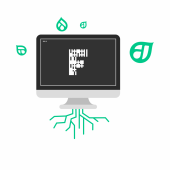Over the years, cloud-based physical security technology has been increasing in power and popularity as many businesses have begun to favour the cloud over on-premises systems. According to cloud security company Thales, 90% of companies worldwide use the cloud. The cloud is essential to data management for most businesses and there are many reasons why.
Cloud-based technology is sweeping the security industry because of its advanced abilities and unparalleled convenience. However, there is a lot of miscommunication and misunderstanding about how the cloud works. Here are some of the most common myths that are holding businesses back from investing in cloud-based physical security so you can see the actual value of the cloud.
1. Cloud systems are more expensive
Physical security technology is often a large investment, whether you need to secure a single office or an entire multi-site enterprise. While the advanced features of physical security systems may mean a high up-front cost, cloud-based technology has long-term ROI that shouldn’t be overlooked.
Updating software and systems is key to keeping your security ahead of the latest vulnerabilities. Cloud-based providers like Openpath automatically upgrade over-the-air without in-person maintenance, which can be beneficial when looking at long-term costs. Plus, because the system is easy to update with the latest and greatest, you’re getting the most advanced security features without having to replace the entire system.
Business needs change over time, so it’s important to consistently evaluate your security systems to see if you need to add or remove features. The benefit of the cloud is that software is generally scalable, allowing you to pay for what you use rather than locking in a long-term contract at installation, which is an effective way to keep your costs in check.
Management is also something many businesses don’t factor into long-term costs. Traditional on-premise security systems may require hiring dedicated staff at each location or office to manage them, and for systems like access control, there’s often ongoing costs to issue and replace key card and fob credentials. Migrating to the cloud enables fully remote management, and mobile-based credentials that are less cumbersome for both staff and users.
The cloud can change how your security system operates by saving costs over time, reducing workloads, and providing better security to your business.
2. You don’t have to manage the cloud
The ongoing maintenance and management of your cloud security system is not the sole responsibility of the vendor; it is a shared responsibility. How responsibility is shared depends on the cloud system and the service provider. With most cloud-based providers, managing and maintaining the server is the responsibility of a third party. It’s important to choose providers that are transparent about their own security measures, such as employing end-to-end encryption, following cybersecurity best practices, and limiting account permissions.
That doesn’t mean your business is totally off the hook, though. You are still in charge of managing your own applications and data security. This means that you need an effective and knowledgeable security team to manage your cloud security system if you want to keep it secure. After all, you wouldn’t want to release sensitive data due to poor data security.
The advantage of sharing cloud management responsibility is that you reduce your burdens while gaining greater flexibility. You can adjust the applications to your needs without purchasing, updating, or hiring IT personnel to manage additional servers, making it easy to scale your physical security system as your business grows.
3. The cloud is just for storage
Many people associate the cloud with mobile phone data storage, but successful businesses will know that the cloud is capable of far more. The cloud can easily manage physical security technologies, from an intercom system and keyless access control, to video security.
Beyond storing limitless system data, cloud-based physical security allows businesses to manage their security remotely and efficiently. Companies can integrate their security systems, manage technologies via one network, and use automation for faster responses with the cloud. This provides businesses with the flexibility to scale their security systems up or back with greater ease.
4. You only need cybersecurity for the cloud
Since the cloud runs on the Internet, surely you should only need cybersecurity to protect the data kept on it? Wrong. Physical security is equally essential as cybersecurity in preventing data breaches. Truthfully, the best way to protect your cloud is to converge your physical and cybersecurity systems for a complete level of protection.
In the cloud, cybersecurity measures handle passwords, authentication, and encryption, essentially protecting your data from digital access. However, physical security protects computers, servers, and sensitive information from physical access breaches that could place sensitive data at risk.
One example is using cloud-based physical security to monitor building access. This protects the business from losing data via physical access, while cybersecurity protects the virtual side. Leveraging cloud-based security systems like Openpath access control enables businesses to easily migrate to converged physical and digital security. For example, Openpath’s real-time access logs can be integrated with data analytics to help security teams identify a potential breach that threatens confidential information. Being able to identify threats faster is crucial in a security breach situation, and having connected systems allows security teams to act quickly and mitigate risks before they pose a greater problem.

Want to learn more about cloud computing from industry leaders? Check out Cyber Security & Cloud Expo taking place in Amsterdam, California and London.
Explore other upcoming enterprise technology events and webinars powered by TechForge here.






